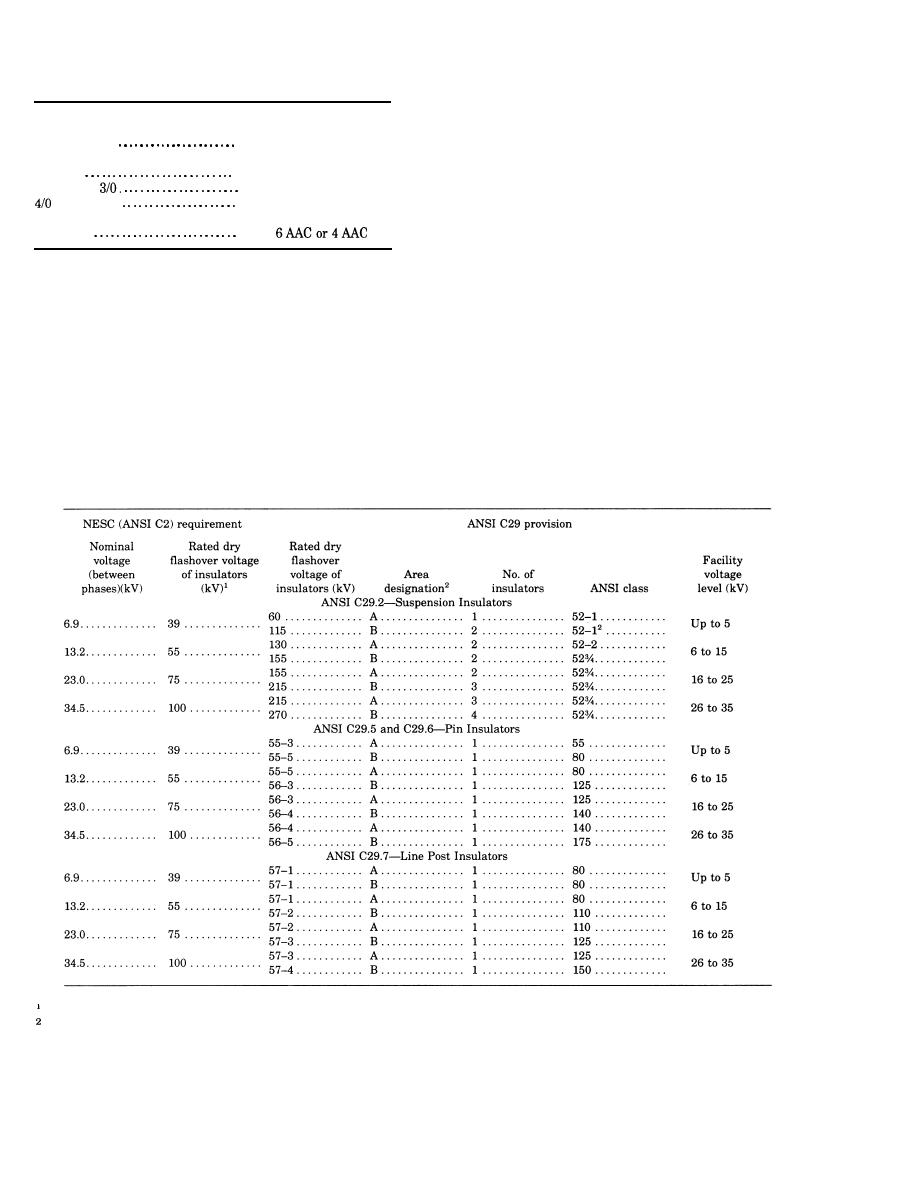

Custom Search
|
|

|
||
 TM 5-684/NAVFAC MO-200/AFJMAN 32-1082
Table 4-3. Tie wire requirements
relate directly to insulator classes. An understand-
ing of the relations between insulator classes and
Tie wire
Conductor
insulation level requirements is helpful in under-
Copper AWG.
Soft-drawn copper AWG
standing why each facility should have a recognized
6 .................................
8
insulation level (class) for its various on-site distri-
4 and 2
6
bution levels if they vary from requirements given
1 through
4
and larger
2
in table 4-4.
AAC,AAAC,orACSRAWG . . . . . . . . .
AWG
a. Code requirements. The NESC spells out dry
Any size.
flashover requirements up to 230 kV These should
be considered a minimum, even though a qualified
conductor and likewise, a covered tie wire should
engineering study could permit lower insulation
always be used on a covered conductor. A loose or
levels. The NESC requires the use of insulators
improper tie wire may be a source of radio interfer-
with higher dry flashover levels where severe light-
ence.
ning, high atmospheric contamination, or other un-
4-47. Pole line insulator class requirements.
favorable conditions exist. The NESC preparers rec-
ognized that dry flashover may not be the best test,
Insulator ratings are not specified by voltage but by
but it has been used for many years with reasonable
ANSI C29 insulator classes. Manufacturers may in-
success. The desirability of using wet flashover as a
dicate nominal line-voltage values but the NESC
basis has been recognized, but no consensus agree-
does not recognize voltage levels. Insulation level
ment has been reached.
requirements are given in the NESC and do not
Table 4-4. Relation of the NESC voltage levels to ANSI C29 class ratings
NESC (ANSI C2) requirement
ANSI C29 provision
Nominal
Rated dry
Rated dry
Facility
flashover voltage
flashover
voltage
(between
of insulators
voltage of
Area
No. of
voltage
insulators
designation 2
insulators
ANSI class
level
phases)(kV)
ANSI
Insulators
60.. . . . . . . . . . . . . A
...............
............... 52-l............
6.9
39
up to 5
115.. ........... B
. . . . . . . . . . . . . . . 2 ...............
.........
130 ............. A
. . . . . . . . . . . . . . . 2 ............... 52-2 ............
13.2 .............
55 ..............
6 to 15
............. B
...............
2
...............
.............
A
............... 2
...............
.............
23.0 .............
75.. ............
16 to 25
.............
............... 3
...............
.............
A ............... 3
...............
.............
26 to 35
34.5 .............
100 .............
.............
............... 4
...............
.............
ANSI C29.5 and
Insulators
A...............
1 . . . . . . . . . . . . . . . 55 . . . . . . . . . . . . . .
up to 5
B...............
1 . . . . . . . . . . . . . . . 80 . . . . . . . . . . . . . .
55-5 ............ A . . . . . . . . . . . . . . .
1 . . . . . . . . . . . . . . . 80.. ............
6 to 15
13.2 .............
55 ..............
............ B ...............
1 ............... 125 .............
56-3 ............ A . . . . . . . . . . . . . . .
1 . . . . . . . . . . . . . . . 125 .............
16 to 25
75 ..............
23.0 .............
............ B ...............
1 ............... 140 .............
A ...............
1
140 .............
26 to 35
34.5 .............
100 .............
............
...............
1 ............... 175 .............
ANSI
Post Insulators
A
. . . . . . . . . . . . . . . 1 ...............
57-1 ............
80.. ............
up to 5
B
............... 1 ...............
............
80.. ............
A
............... 1
57-l............
80 ..............
6 to 15
55 . . . . . . . . . . . . . .
B
...............
57-2 ............
...............
110.. ...........
A
............... 1 ...............
110.. . . . . . . . . . . .
57-2 ............
16 to 25
75 . . . . . . . . . . . . . .
B
. . . . . . . . . . . . . . . 1 ...............
57-3 ............
125 .............
A
. . . . . . . . . . . . . . . 1 ...............
57-3 ............
125 .............
26 to 35
B
. . . . . . . . . . . . . . . 1 ...............
57-4 ............
150 .............
The rated dry flashover voltage is based on manufacturer's tests where more than one insulator is required.
Use the A value in areas where the atmosphere is dry (desert) or where fog occurs only to a limited degree and there is not more than
moderate industry contamination. Use the B value in areas where medium-to-heavy fog is common occurrence and there is medium
industrial contamination along a salt-water coast line.
4-24
|
 
|
|
 |
||